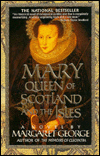
She was a child crowned a queen....
A sinner hailed as a saint....
A lover denounced as a whore...
A woman murdered for her dreams...
At 870 pages long, this book is a BIG book, but within it's pages is a big story taking place in three countries at a very turbulent time in history! In fact at times it felt as though I was carrying a brick around as I lugged it from one train ride to the next.
The book is divided into three parts, the first dealing with Mary's time as Queen of France, the second her time as Queen of Scotland and the third part deals with her time as the guest/prisoner of Queen Elizabeth I.
Mary was born to James V of Scotland and Marie de Guise, not long after the death of her two older brothers. Within days of her birth, James V was dead and Mary was crowned Queen of Scotland, with her mother acting as regent. When she was about 5 years old she was betrothed to the young Dauphin of France and she was moved to France, leaving her mother behind in her role as regent, and went to live with the French Court, under the care of Catherine de Medici and Diane de Poitiers. Married at 15, widowed at 18, after having become Queen only a year or so before, Mary found herself no longer Queen with no role to fulfill so she returns to Scotland to take up her role there.
Mary's reign as Queen of Scotland was incredibly tumultuous, with her reign coinciding with the emergence of John Knox as leader of the Protestant movement in Scotland. Mary was intensely passionate about her religion and even before she returned to Scotland, religion was potentially a stumbling block. In quite unusual circumstances, Mary became the Catholic Queen of a Protestant country, attracting the wrath of John Knox, and apparently a personal disliking from him as well. Later during her reign, when some of her actions were probably less than wise, Knox had more reason to castigate Mary and he did so very vocally.
Mary and Elizabeth were cousins, who had never met, and yet seemed to feel some level of kinship between them, and yet most of the problems between them occurred because Elizabeth would not formalise the succession. Initially, there were problems because when Queen Mary I died there were some in the French court who suggested that Mary Stuart was the next true Queen of England and even went as far as including the title of Queen of England for her, which did not go down well in the English court. Later, it seemed that the reluctance was due to the fact that Mary was either being portrayed as being actively involved in plots against Elizabeth, or in some cases actually was involved in these plots.
In much the same way as Elizabeth I was being courted in London by a variety of members of the royal families of Europe as potential bride, so too Mary's mind had turned to marriage, and when Henry, Lord Darnley entered the fray it seems as though Mary was smitten, and marriage was hastily arranged, despite the fact that Elizabeth had not given her approval. Here we see the Mary who is headstrong, who makes hasty decisions, and who would appear to lack the ability to make accurate judgement as to the characters of the people around her. The marriage is very quickly in trouble, with Darnley known to frequent the various establishments wherever he happened to be and in the end becoming incredibly ill with what appeared to be a sexually transmitted disease, but not before she becomes pregnant with her son and heir. Mary knows her marriage is in trouble, and when she finds herself attracted to Lord Bothwell, it would seem that her life was to be further complicated until there are more plots, betrayals and schemes, this time to murder her husband.
Within months, Bothwell has arranged a hasty divorce, and kidnaps the Queen "forcing" her to marry him, thereby causing the few loyal lords Mary had left to turn against her, because of the underhanded methods Bothwell employed in several situations. This time is a time of happiness for Mary, with the man that she loves by her side, despite the fact that the Lords of Scotland refuse to acknowledge Bothwell as her husband and king. This eventually leads to a showdown at Carberry Hill where Mary is taken into protections by the Lords, thus in reality ending her freedom forever. Bothwell flees and eventually ends up taken prisoner in Denmark and Sweden where he stays until his grisly death.
The book covers in great length the various plots against Mary by the people who had pledged their loyalty to her, including her illegitimate half brother James, who in the end would rule in her stead. Also covered are the authors thoughts regarding the depth of Mary's involvement in the murder of Darnley, in the aforementioned kidnapping and in the plots against Elizabeth that cost her her life.
The Mary we grow to know is a very complex woman - at various times innocent child, powerful ruler, woman in love, alternatively cautious but also impulsive, someone who was betrayed many times, and yet was the object of great devotion from many of her friends, including some of her jailers. When she comes to England without first having permission from Elizabeth she shows her headstrong nature, yet she submitted to being Elizabeth's guest for quite a long time.
Once in England, Mary is guest of Elizabeth, at times in a degree of luxury, but as the period went on the pretense of being a guest was dropped, and the reality of life as a prisoner set in. Mary's imprisonment in England last for 20 odd years before eventually Mary was caught in a trap set up to try and force Elizabeth's hand into having her executed. For Mary, she viewed these events as being aimed at her because of her religion, and she was very forthright in defending herself by accusing her accusers of taking the actions they had because she refused to embrace the Protestant faith.
One of the things that I found most interesting was that there was quite a long time where Mary spent time in imprisonment in Sheffield Manor and Sheffield Castle, whilst under the care of the Earl of Shrewsbury. The thing that was interesting to me about this is that when I lived in Sheffield I lived about 10 minutes from Sheffield Manor and yet never knew anything about it. Sheffield, in my opinion, can't really be commended for keeping it's history alive! Maybe one day I will get back there again and if I do I shall be sure to make a visit to Sheffield Manor. The Castle is long gone, buried between some truly ugly markets in the city centre.
It would be a huge achievement for an author to capture a reader's attention entirely for such a big book, and there were parts in the book that were a little dry, but it wasn't ever long before something else happened drawing your attention back again.
Overall this was a very readable story that expanded on what is known about Mary, Queen of Scots - a woman of contradictions.
Rating 4/5







Oh I loved this book. It's the only one I've read by George (although I think I have all of them) and it was so...rich and delicious.
ReplyDeleteSorry, I tend to compare really good books to food, especially the big meaty ones. Oops, there I go again!!!